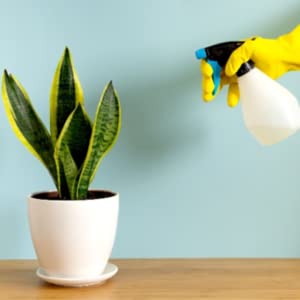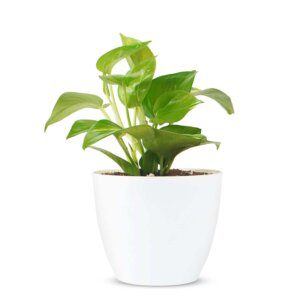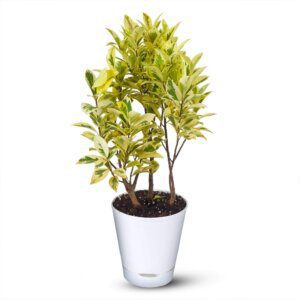| Plants Care Instructions | Don’t use chlorine water (usually tap water) as it kills the root., It should stay moist. If the coco peat is becoming light brown, it should be sprayed with water, Expose the plants to 3-4 hours of daily filtered/ indirect sunlight, Avoid temperature shock by shifting plant between indoors and outdoors on a regular basis for better growth., RO water is chlorine free and recommended, Check the coco peat before watering. |
|---|


Snake Plant Variegated–Sansevieria Hahnii Goldstar
Ever wonder why you never see artificial snake plants? It’s because you don’t need artificial versions. The real thing is pretty much unkillable and survives in almost any growing condition.Snake plants, also known as “Mother-in-Law’s Tongue” and Sansevieria, are one of the easiest houseplants to take care of. This succulent plant is very forgiving and perfect for beginners. Here’s how to keep them happiest.


Light& Temperature
Snake Plants can survive in highly lit spaces as well as shaded&very low-lit areas. However, they do prefer bright indirect light, set by a window facing east. Avoid direct sunlight as it has the potential to dry them out quickly. Very low light can make the snake plant’s leaves very weak and stretched out, causing them to wilt and flop over instead of standing upright as they should. For room temperature, it is ideal to keep the space at a minimum of 65 degrees.



Watering
Once you have the right soil and pot, your snake plant will be set up for success. Only water the plant once it has completely dried out. Depending on multiple factors, including the size of the plant and humidity levels in your home, the time between waterings can range anywhere from 2-6 weeks. When watering, make sure to not oversaturate the soil and remove any excess water that is left on the saucer.


Soil & Fertilization
Snake plants prefer a loose, well-drained potting mix. This plant will do well in sandier soils. Use a potting media low in peat content. An all-purpose cactus potting soil is a good choice. Feed with a mild cactus fertilizer during the growing season or a balanced liquid slow-release 10-10-10 fertilizer or a 20-20-20 fertilizer diluted to half strength. Do not fertilize in the winter.


Potting &Repotting Sansevieria
When potting, choose a sturdy pot material as strong roots can easily crack and break weak pots. Snake Plant is generally a slow grower that rarely needs repotting, but if given ample sunshine, they might grow rapidly and require repotting or dividing. The best time to repot these plants is in the spring. When repotting, always use fresh potting soil, a cactus potting mix, or a mixture of both.
Propagating Sansevieria
Snake plants produce rhizomes and are easily divided. Although this can be done any time, spring is best. Your newly propagated plants will also grow faster as summer is growing season. You can also propagate snake plants through leaf cuttings. Just cut 2 to 3-inch pieces of a leaf and place them about 1 inch deep in soil appropriate for snake plants. Make sure to plant cuttings facing up, the same direction they were growing. Enjoy! Snake plants look great in varied-height clusters.


Plant Care Tips
- Pruning:Using sterile pruning shears, scissors, or a sharp knife, remove leaves at the soil line or cut off damaged or mature leaves to encourage new growth. The best time to prune is during the growing season—usually spring or summer.
- Overwintering: Snake plant is a tropical plant that can die in temperatures consistently lower than 50 degrees Fahrenheit or if affected by a wintery frost. Bring the plant indoors before temperatures drop that low. Keep the snake plant in a warm room, protected from cold drafts, and maintain the soil on the drier side.
- All-over yellowing orbrown leaves indicates that the plant is getting too much water.Overwatering causes root rot and stresses out the plant, making it more susceptible to pests.
- Leaves falling or drooping: Healthy snake plant leaves grow upward and stand erect, but too much water, insufficient light, or poor potting material can make the plant’s leaves droop or flop over. Move the plant to a brighter location, reduce the frequency of watering, and change the soil to one that drains better, if necessary.
- Root rot: Root rot is caused by too much standing water.Controlling your watering habits and ensuring the dwarf snake plant’s soil is well-draining can prevent root rot.
- Mealybugs:Most snake plant infestations are attributed to mealybugs. Using mild dish soap with rubbing alcohol and water can remove mealybugs quickly.
Our Favourable Aspects
- Potting Mixture: It’s a mixture of appropriate amounts of soil, cocopeat & organic vermicompost. Provides best environment to the plant’s roots. It also contains slow-release Fertilizer which gives nutrients to the plants every time it is watered for 6 months.
- Packaging: Plant is secured in a good quality cardboard packaging. Inner Box holds the potted plant in place so that any movement during transit does not affect the plant. Outer box has slits which allow the plant to breathe freely during transit


















Reviews
There are no reviews yet.